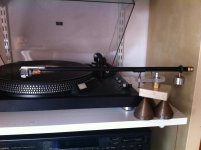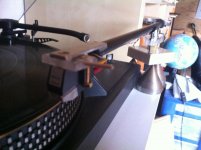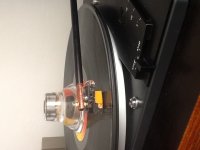Thanks guys !
Should I apply a form of anti skating when doing a shorter rod version ?
THX
Paul
Should I apply a form of anti skating when doing a shorter rod version ?
THX
Paul
I haven't kept up with this thread very much in the past several months, but wasn't there supposed to be a partial kit available at some point? Or at least some of the harder to fabricate or find parts?
With work and so many other projects on my plate, it is just so hard to find the time to track everything down.
I'm a pretty competent DIY'r, so I'm not expecting anything PnP. Just a collection of some of the parts.
Thanks.
With work and so many other projects on my plate, it is just so hard to find the time to track everything down.
I'm a pretty competent DIY'r, so I'm not expecting anything PnP. Just a collection of some of the parts.
Thanks.
Shorter arm
Hi
If you look at the pics I posted earlier, this is a 10" version of the arm and at this length, I decided to add bias correction. If you look carefully at the pictures, it is very simple to apply.
Chris
Hi
If you look at the pics I posted earlier, this is a 10" version of the arm and at this length, I decided to add bias correction. If you look carefully at the pictures, it is very simple to apply.
Chris
I'm have been inspired!
Thanks for the thread guys especially Stew. I have been following this and the turntable thread since Christmas... And now built a dual 1210 based manual (auto stripped replinthed) turntable with a pretty faithful Nanook 219 12" tonearm. Will take some pics and post them later this week however here are some pics of the work in progress. Wires are temporary in these pics.
Cheers again,
Dan
P.s span it for the first time Monday... It's AWSOME!
I'll add detail on the dual side of things in Stews turntable thread.
Thanks for the thread guys especially Stew. I have been following this and the turntable thread since Christmas... And now built a dual 1210 based manual (auto stripped replinthed) turntable with a pretty faithful Nanook 219 12" tonearm. Will take some pics and post them later this week however here are some pics of the work in progress. Wires are temporary in these pics.
Cheers again,
Dan
P.s span it for the first time Monday... It's AWSOME!
I'll add detail on the dual side of things in Stews turntable thread.
Attachments
Hey Eco-Dan,
Looks great to me! I have the plans to do the same with an Dual 1220 deck. Is it still suspended or fixed mounted on the plinth?
Regards,
Mark
Looks great to me! I have the plans to do the same with an Dual 1220 deck. Is it still suspended or fixed mounted on the plinth?
Regards,
Mark
Hey Eco-Dan,
Looks great to me! I have the plans to do the same with an Dual 1220 deck. Is it still suspended or fixed mounted on the plinth?
Regards,
Mark
Thanks Mark, it's bolted securely down, suspension springs are gone and the travel bolts are holding it in place. In fact I gutted everything off it I could, only the idler and pitch adjust mechanism remain. Cam wheel, everything else is gone (except the tone arm lift lever which now releases the idler mechanism). I'll post a full run down on the Nanook turntable thread as soon as I get a chance on the weekend.
Nanook 219 totally worth the effort.
Wow, tone arm is amazing! Not only is the treble and bass tighter (idler drive versus direct may account for some of the base improvement), but orchestral music is more focused with better separation than I thought my At120e was capable of. Best investment I've made in my system for a while (and cheapest).
Next job is to tidy the wires and make an arm lift.
Wow, tone arm is amazing! Not only is the treble and bass tighter (idler drive versus direct may account for some of the base improvement), but orchestral music is more focused with better separation than I thought my At120e was capable of. Best investment I've made in my system for a while (and cheapest).
Next job is to tidy the wires and make an arm lift.
Okay details on my arm.
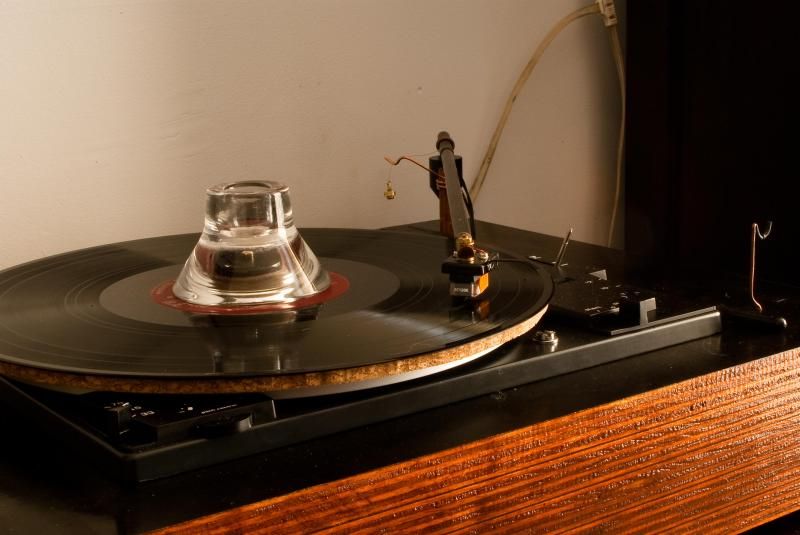
I have tried to stay fairly faithful to the principle design as it has unfolded through this thread. To that end effective length is exactly 12" with an extra 4" behind to allow my 90g hanging counter weight to be hung off copper wire wound around heatshrink.
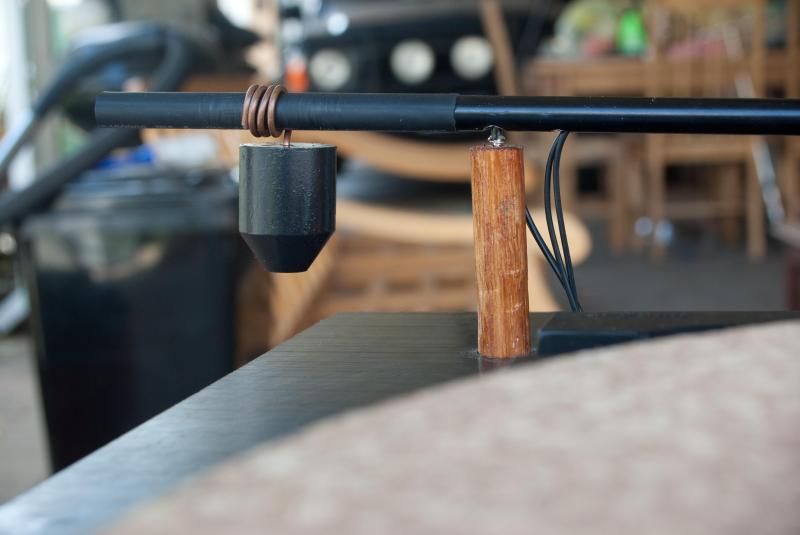
The arm is of course an aluminium arrow. The pivot is a Parker pen refill inserted into a 12mm diameter dowel which is snuggly fitted into the plinth to allow height adjustment. The female part of the bearing is simply the dimple left by drilling through the bottom of the tone arm through slightly into the top. No dowel or other packing was used at this point.
The head is held to into the end of the arm via a honed wooden dowel, which is flattened on one side to allow the passage of wires and the secure mounting of the cartridge assembly.
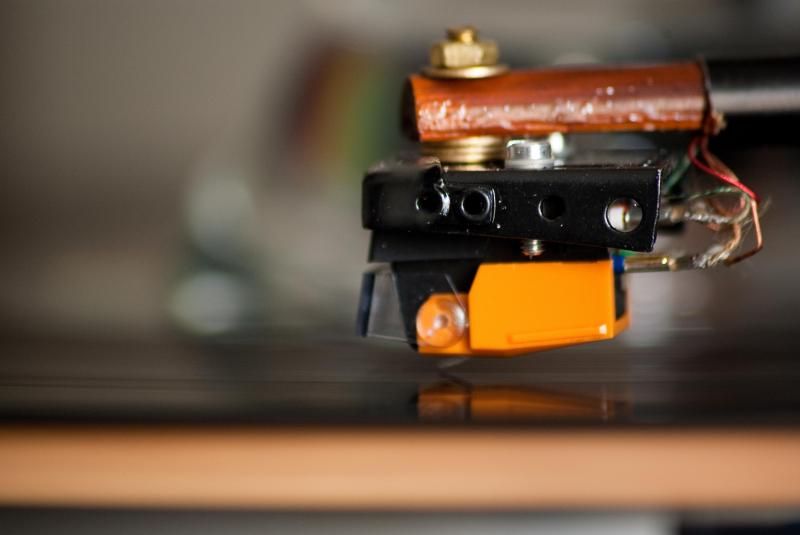
The dowel is a tight press fit into the arm. The cartridge is mounted in an old very light headshell that has been cut down and drilled to pivot directly at the effective length of the tone arm so I can pivot the cartridge to the correct angle whilst keeping the stylus tip perfectly in line with the arm (looks off in that picture but is adjustable... I'll slide it back into alignment!).
Wires are headphone (type where individual strands are coated in some sort of plastic). Probably the weakest link in the whole thing but it is a 219 tonearm! I didn't strip off all the cable sheath as the wire would snap. Arm tube is stuffed with synthetic cotton wool stuff to dampen it.
As an afterthought a basic fishing line and weight antiskate device has been fitted. I feel safer knowing its on there, but I'm not convinced its an improvement to sonics.
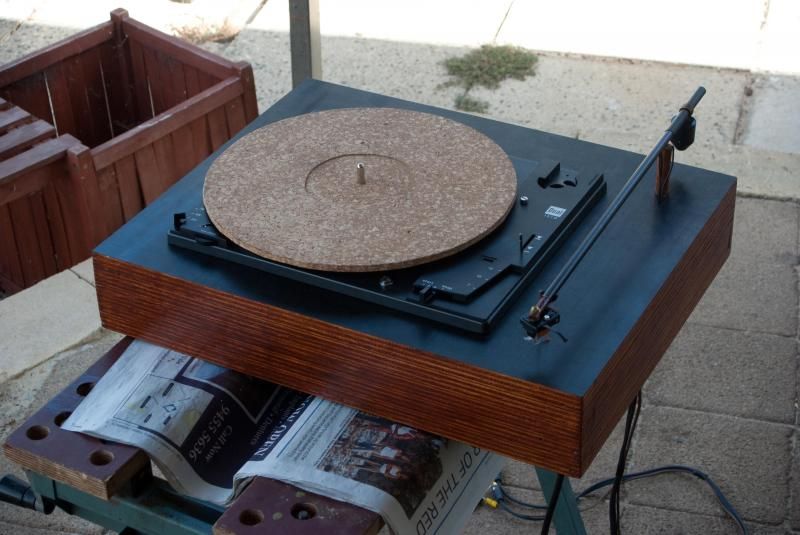
Cork Matt has also been spun out of a floor as an improvement over the old rubber plastic mat that was sucking the bass out of everything.
Turntable as previously mentioned is a stripped down Dual 1210 that I have re-plinthed. I'll post a link on its build when I post it shortly.
Cheers Stew and everyone for this thread, its nice to put something back in after having a good read of everything that's been posted!

I have tried to stay fairly faithful to the principle design as it has unfolded through this thread. To that end effective length is exactly 12" with an extra 4" behind to allow my 90g hanging counter weight to be hung off copper wire wound around heatshrink.

The arm is of course an aluminium arrow. The pivot is a Parker pen refill inserted into a 12mm diameter dowel which is snuggly fitted into the plinth to allow height adjustment. The female part of the bearing is simply the dimple left by drilling through the bottom of the tone arm through slightly into the top. No dowel or other packing was used at this point.
The head is held to into the end of the arm via a honed wooden dowel, which is flattened on one side to allow the passage of wires and the secure mounting of the cartridge assembly.

The dowel is a tight press fit into the arm. The cartridge is mounted in an old very light headshell that has been cut down and drilled to pivot directly at the effective length of the tone arm so I can pivot the cartridge to the correct angle whilst keeping the stylus tip perfectly in line with the arm (looks off in that picture but is adjustable... I'll slide it back into alignment!).
Wires are headphone (type where individual strands are coated in some sort of plastic). Probably the weakest link in the whole thing but it is a 219 tonearm! I didn't strip off all the cable sheath as the wire would snap. Arm tube is stuffed with synthetic cotton wool stuff to dampen it.
As an afterthought a basic fishing line and weight antiskate device has been fitted. I feel safer knowing its on there, but I'm not convinced its an improvement to sonics.

Cork Matt has also been spun out of a floor as an improvement over the old rubber plastic mat that was sucking the bass out of everything.
Turntable as previously mentioned is a stripped down Dual 1210 that I have re-plinthed. I'll post a link on its build when I post it shortly.
Cheers Stew and everyone for this thread, its nice to put something back in after having a good read of everything that's been posted!
Link to turntable build is here http://www.diyaudio.com/forums/analogue-source/245863-nanook-turntable-thread-26.html
I'm the current, regional "Where's Waldo" champion of Saskatchewan. Exiting things, here.
jk 😉
My wife was looking at those in Ikea a few months ago, which means I was looking at them too.
jk 😉
My wife was looking at those in Ikea a few months ago, which means I was looking at them too.
Ta  , I'm pretty happy with it for a first attempt.
, I'm pretty happy with it for a first attempt.
Also fitted a suspended weight to replace the idler spring now, sounding pretty sweet (even with the industrial sounding clunk when I turn it off!).
 , I'm pretty happy with it for a first attempt.
, I'm pretty happy with it for a first attempt.Also fitted a suspended weight to replace the idler spring now, sounding pretty sweet (even with the industrial sounding clunk when I turn it off!).
Interesting observation, with this arm my at120e sounds wonderful at 1.4g, before on my pioneer 512 I had to run it at 1.9g to get any where near the the quality of sound reproduction. The agility of this arm is amazing, even at heavier weights it massively out performers my old pioneer. 

I have been following this thread with great interest and decided to take the plunge. Here's where I'm at now:

Arm tube is composed of two D-section of wood (13 mm wide, teakwood I think). Semi-circular groove is cut on the flat surfaces to make hole for tonearm wires. I started with 13 mm pieces and have sanded it down as much as I dared (I am a bit apprehensive that the tube wall would become too thin). Tube diameter is now slightly larger than 11 mm, not too uniform either as it hand-sanded.
Female bearing is a piece of brass. I used a center punch to hammer (literally) a near-conical section that is slightly larger than the tip of a Parker jotter ballpen refill. The surface of the cone is super smooth as it was hammered with a punch.
Counterweight is temporarily borrowed from an Origin Live Silver arm (106 grams), hung with a solid copper wire (without removing insulation in the hope that the insulation would serve to somewhat decouple the stub to weight). Today I tried spinning it on my turntable and it traced the groove like a champ, until the stylus of the old Shure M44-7 came out on its own. I checked and saw that the fit of the stylus was indeed very loose.
To do: oil the wood, glue the two sections together, varnish it (I am inclined to natural finish), re-design and simplify the headshell (I used a Schroeder like headshell but mine has too many linkages and it is not rigid enough), figure out what to use as tonearm wire, get a machinist to make counterweight, finish arm lift, make arm rest, etc.
Some more pics:






Arm tube is composed of two D-section of wood (13 mm wide, teakwood I think). Semi-circular groove is cut on the flat surfaces to make hole for tonearm wires. I started with 13 mm pieces and have sanded it down as much as I dared (I am a bit apprehensive that the tube wall would become too thin). Tube diameter is now slightly larger than 11 mm, not too uniform either as it hand-sanded.
Female bearing is a piece of brass. I used a center punch to hammer (literally) a near-conical section that is slightly larger than the tip of a Parker jotter ballpen refill. The surface of the cone is super smooth as it was hammered with a punch.
Counterweight is temporarily borrowed from an Origin Live Silver arm (106 grams), hung with a solid copper wire (without removing insulation in the hope that the insulation would serve to somewhat decouple the stub to weight). Today I tried spinning it on my turntable and it traced the groove like a champ, until the stylus of the old Shure M44-7 came out on its own. I checked and saw that the fit of the stylus was indeed very loose.
To do: oil the wood, glue the two sections together, varnish it (I am inclined to natural finish), re-design and simplify the headshell (I used a Schroeder like headshell but mine has too many linkages and it is not rigid enough), figure out what to use as tonearm wire, get a machinist to make counterweight, finish arm lift, make arm rest, etc.
Some more pics:





I like so many aspects of your design. I assume the heavier weight of this arm is compatible with the shures compliance?
Love the look of the raw wood, perhaps clear low sheen varnish? Yeah I found the headshell a nuisance to start with, but I'm sure you'll find a way to make it work. Overall look is very pleasing to the eye.
Love the look of the raw wood, perhaps clear low sheen varnish? Yeah I found the headshell a nuisance to start with, but I'm sure you'll find a way to make it work. Overall look is very pleasing to the eye.
Last edited:
- Status
- Not open for further replies.
- Home
- Source & Line
- Analogue Source
- my latest iteration of "Nanook's 219 tonearm"..
